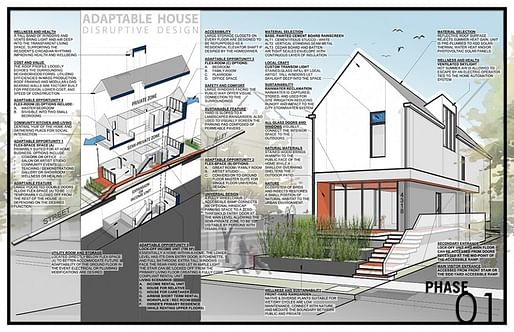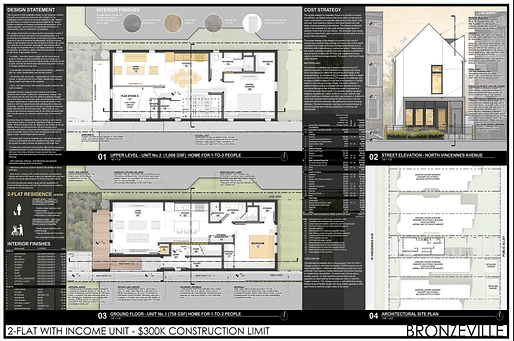

A new housing typology will be coming to the Chicago neighborhoods of West Humboldt Park and Bronzeville, where Perkins + Will architect Greg Tamborino will bring his independently-produced, competition-winning affordable housing designs to a pair of vacant lots.
Tamborino was recently announced as the winner of the Disruptive Design competition, a contest looking to "address the challenges associated with designing and building affordable, owner-occupied housing," according to competition organizers.
Tamborino's designs were selected from among 133 international competition entries, and bested proposals by competition finalists Joel Huffman and teammates Georgi Todorov and Petya Petrova.
Tamborino's designs stand out because of the home's adaptable qualities and thoughtfully composed organization, according to competition jury members. Tamborino includes a generous entry into the home, for example, where a fire-rated partition separates a stairwell from the living room and kitchen of the lower level. The partition allows the building owners to subdivide the building in order to let out either floor as an income-generating unit. The partition, according to the design, can also be left partially open so that the entire home can be occupied by a single family or group of people. The home's lower level includes a living room at the front with a central kitchen and bathroom that leads to a back bedroom or flex-space.

Upstairs, the home can include a stacked kitchen in the event the building is made up of two units. If the home is being inhabited as a single-unit, this level can be used for bedrooms and other flexible spaces, floor plans indicate. The 1,066-square-foot home also only fills out half the footprint of conventional Chicago bungalow types, meaning that there is room for the building to be expanded as needed in the future. The arrangement also results in a sizable back yard and a smaller overall building that is cheaper to construct. The home is projected to cost roughly $300,000 to build.

The home also gets points for its Americans with Disability Act compliance: The lower-level unit is accessed from an ADA-compliant ramp while interior spaces along this level are sized to appropriately accommodate wheelchairs. Aside from promoting universal access, the arrangement can also help to accommodate aging-in-place arrangements for any potential homeowner, according to the competition boards.
The proposal indicates that the exterior of the home can be clad in "humble" materials like cement board and other low-cost finishes.
Moving forward, Tamborino will receive $20,000 to complete a set of construction drawings for the homes. When those plans are completed, competition sponsor Related Midwest will fund the construction of two of his designs. The homes are set to be completed in 2020.
As one of the CIRs (curmudgeons-in-residence) here, a favorite target of mine is the frequent editorial spin touting newness and novelty.
Sometimes that description fits, but often not, instead being forced onto the piece.
These look nice. The potential for flexibility as one or two units seems like a good idea. I hope they get built.
But maybe we should wait and see if two new houses --yet to be built, much less permitted or even drawn and detailed for construction-- constitute a "new typology" that will transform neighborhoods.
Are you sure you want to block this user and hide all related comments throughout the site?
All 3 Comments
Will the homes be built well enough, is the design substantial enough that, say, 50 years from now the gentry will buy them up and restore them, as has happened with many homes from the past we once took for granted, rather than raze and replace?
Not that I'm promoting gentrification, but instead am setting a standard that the people who will live in them now might enjoy.
To clarify "2-Flat" is the name of the new typology?
not new, these are very common in Chicago https://blockclubchicago.org/2019/02/18/wait-are-two-flats-only-a-chicago-thing-why-we-remain-obsessed-with-the-uniquely-chicago-home-after-a-century/
As one of the CIRs (curmudgeons-in-residence) here, a favorite target of mine is the frequent editorial spin touting newness and novelty.
Sometimes that description fits, but often not, instead being forced onto the piece.
These look nice. The potential for flexibility as one or two units seems like a good idea. I hope they get built.
But maybe we should wait and see if two new houses --yet to be built, much less permitted or even drawn and detailed for construction-- constitute a "new typology" that will transform neighborhoods.
Archinect
This is your first comment on Archinect. Your comment will be visible once approved.